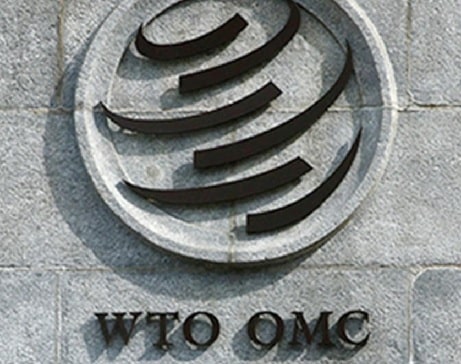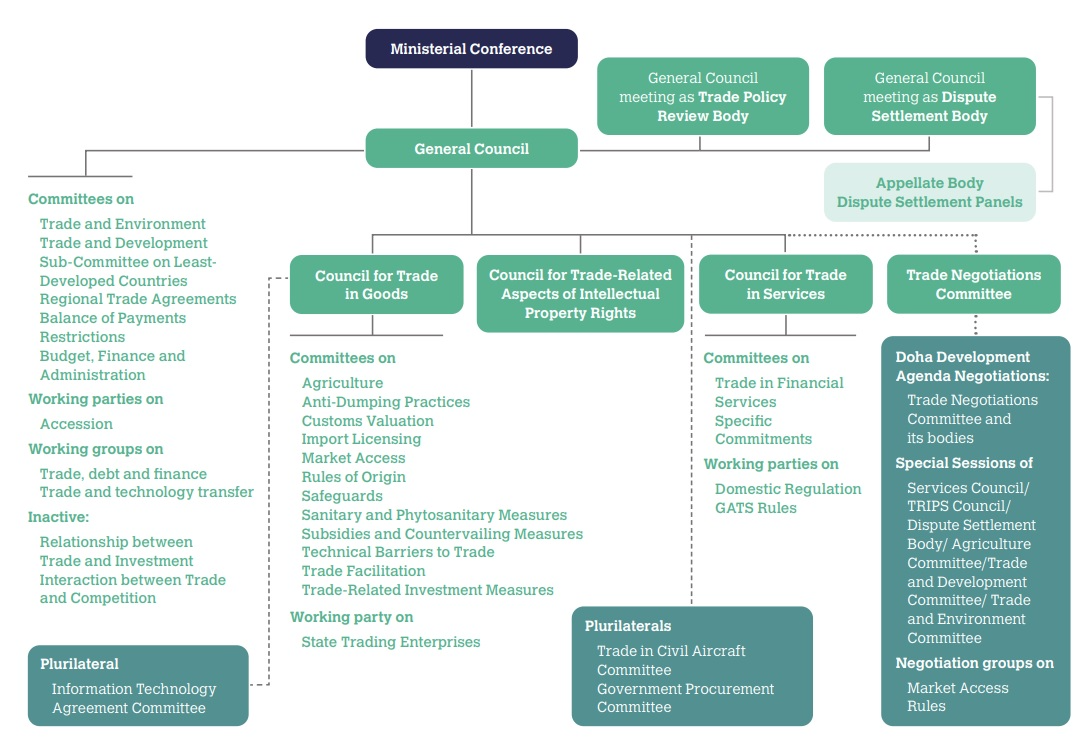What’s in today’s article?
- Why in news?
- World Trade Organization (WTO)
- What is World Trade Organization (WTO)?
- Dispute Settlement Body of WTO
- News Summary: WTO panel rules against India
- Background: WTO panel rules against India
- What was India’s stand on the imposition of duties on IT products?
- What options does India have after the present WTO ruling?
Why in news?
- The dispute settlement panel of the World Trade Organization (WTO) had ruled that India had violated global trading rules in a dispute with the European Union (EU), Japan and Taiwan over import duties on IT products.
World Trade Organization (WTO)
What is World Trade Organization (WTO)?
- About
- WTO is an international organization that promotes and regulates global trade among nations.
- The WTO was established on January 1, 1995 by replacing the General Agreement on Tariffs and Trade (GATT).
- GATT had been in existence since 1948.
- It has 164 member countries, representing over 98% of global trade.
- It is headquartered in Geneva, Switzerland, and operates on a consensus-based decision-making process.
- Objective
- Its main objective is to promote free and fair trade by eliminating barriers to trade, such as tariffs and quotas, and by ensuring that trade disputes are resolved through a transparent and predictable process.
- Functions
- The WTO is responsible for:
- setting the rules of international trade,
- negotiating and implementing trade agreements,
- providing a forum for trade negotiations, and
- monitoring national trade policies.
- The WTO also works closely with other international organizations, such as the World Bank and the International Monetary Fund, to promote global economic development and reduce poverty.
- The WTO is responsible for:
- Organizational structure of WTO
- Highest authority: the Ministerial Conference
- Topmost is the ministerial conference which has to meet at least once every two years.
- The Ministerial Conference can take decisions on all matters under any of the multilateral trade agreements.
- Second level: General Council in three guises
- Day-to-day work in between the ministerial conferences is handled by three bodies: The General Council; The Dispute Settlement Body; The Trade Policy Review Body.
- The General Council acts on behalf of the Ministerial Conference on all WTO affairs.
- It meets as the Dispute Settlement Body and the Trade Policy Review Body to oversee procedures for settling disputes between members and to analyze members’ trade policies.
- Third level: councils for each broad area of trade, and more
- Three more councils, each handling a different broad area of trade, report to the General Council:
- The Council for Trade in Goods (Goods Council);
- The Council for Trade in Services (Services Council);
- The Council for Trade-Related Aspects of Intellectual Property Rights (TRIPS Council).
- Three more councils, each handling a different broad area of trade, report to the General Council:
- Highest authority: the Ministerial Conference
Image Caption: Organisational Structure of WTO
Dispute Settlement Body of WTO
- The General Council convenes as the Dispute Settlement Body (DSB) to deal with disputes between WTO members.
- The DSB has authority to:
- establish dispute settlement panels,
- refer matters to arbitration, adopt panel, Appellate Body and arbitration reports,
- maintain surveillance over the implementation of recommendations and rulings contained in such reports, and
- authorize suspension of concessions in the event of non-compliance with those recommendations and rulings.
News Summary: WTO panel rules against India
- The dispute settlement panel of the WTO ruled that India’s imposition of tariffs on mobile phones and electronic components violates its commitment under the Information Technology (IT) Act under the multilateral trade body.
Background:
- The EU, Chinese Taipei (Taiwan) and Japan dragged India to the WTO dispute in 2019 on imposing tariffs on certain information and communications technology goods.
- These products include mobile phones, microphones, transmission apparatus for radio broadcasting etc.
- As per these petitions, India is signatory to the 1996 Information Technology Agreement (ITA).
- Hence, it is required to eliminate tariffs on a range of products, including mobile handsets.
- Many countries had complained that the imposition of tariffs on IT products by India was against the principles agreed upon under ITA.
What was India’s stand on the imposition of duties on IT products?
- India’s argument
- At the time of signing the ITA, products such as smartphones did not exist. Hence, it was not bound to eliminate tariffs on such items.
- Decision to increase import tariffs on mobile phones has paid off handsomely
- It resulted in significant investments, including those from Apple and Foxconn.
- India’s mobile phone exports will soon cross $10 billion a year.
What options does India have after the present WTO ruling?
- India has option to appeal against the present ruling.
- If India does so, the case will sit in legal purgatory since the WTO’s top appeals bench is no longer functioning due to U.S. opposition to judge appointments.
- Legal purgatory is a term used to describe a situation where a legal case or dispute is in a state of limbo, without resolution or a clear path forward.
Q1) What is legal purgatory?
Legal purgatory is a term used to describe a situation where a legal case or dispute is in a state of limbo, without resolution or a clear path forward.
Q2) What is Custom Duty?
Custom Duty is a tax imposed on goods when they are transported across international borders.
Source: WTO panel rules against India in IT tariffs dispute with EU, others | WTO | Business Standard
Last updated on December, 2025
→ Check out the latest UPSC Syllabus 2026 here.
→ Join Vajiram & Ravi’s Interview Guidance Programme for expert help to crack your final UPSC stage.
→ UPSC Mains Result 2025 is now out.
→ UPSC Notification 2026 is scheduled to be released on January 14, 2026.
→ UPSC Calendar 2026 is released on 15th May, 2025.
→ The UPSC Vacancy 2025 were released 1129, out of which 979 were for UPSC CSE and remaining 150 are for UPSC IFoS.
→ UPSC Prelims 2026 will be conducted on 24th May, 2026 & UPSC Mains 2026 will be conducted on 21st August 2026.
→ The UPSC Selection Process is of 3 stages-Prelims, Mains and Interview.
→ UPSC Result 2024 is released with latest UPSC Marksheet 2024. Check Now!
→ UPSC Prelims Result 2025 is out now for the CSE held on 25 May 2025.
→ UPSC Toppers List 2024 is released now. Shakti Dubey is UPSC AIR 1 2024 Topper.
→ UPSC Prelims Question Paper 2025 and Unofficial Prelims Answer Key 2025 are available now.
→ UPSC Mains Question Paper 2025 is out for Essay, GS 1, 2, 3 & GS 4.
→ UPSC Mains Indian Language Question Paper 2025 is now out.
→ UPSC Mains Optional Question Paper 2025 is now out.
→ Also check Best IAS Coaching in Delhi


















